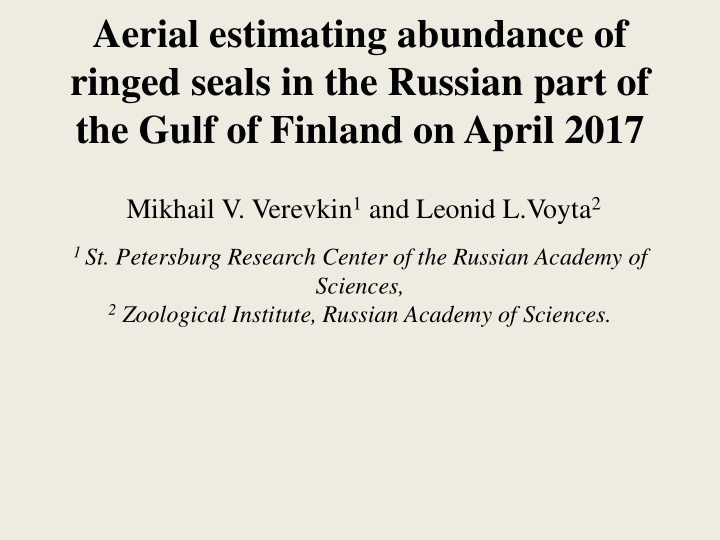



Aerial estimating abundance of ringed seals in the Russian part of the Gulf of Finland on April 2017 Mikhail V. Verevkin 1 and Leonid L.Voyta 2 1 St. Petersburg Research Center of the Russian Academy of Sciences, 2 Zoological Institute, Russian Academy of Sciences.
The scheme of observation sectors for both boards of aircraft. Two bands of 400 m are shown, according to the HELCOM method ( Härkönen & Lunneryd 1992, Galatius et al., 2014).
Satellite image of the ice cover on the Russian part of the Gulf of Finland according to NASA satellite data on April 11th, 2017.
Schematic map of the aerial survey on April 11th with meeting points of Baltic ringed seals (red points) and grey seals (g).
The result of the survey on the 11 of April • On April 11th between 10:30 and 14:30 a total of 1 639.84 km2 was surveyed; the length of the flight route was 361.199 km. In total 22 transects of meridional direction were worked out; the average distance between transects was 4.5 km. The actual studied area was 289 km 2 , which corresponds to the number of elementary segments of the route (1 segment = 1 km 2 ). The total number of the met animals was nine specimens. Relative spatial density of individuals per 1 segment (= 1 km 2 ) of the route was 0.031 ± 0.004 (m ± 95% confidence interval), SD = 0.17. The expected number of ringed seals within the studied area was 51 individuals, with a 95% confidence interval of 44 to 57 individuals.
Satellite image of the ice cover on the Russian part of the Gulf of Finland according to NASA satellite data on April 15th, 2017.
Schematic map of the aerial survey on April 15th with meeting points of Baltic ringed seals (red points) and grey seals (g); light- green triangles are meeting points of ringed seals without the transects.
The result of the survey on the 11 of April On April 15th between 9:16 and 14:11 a total area of 2451 km 2 was • surveyed; the length of the flight route was 490.2 km. In total 21 transect of meridional direction were worked out; the average distance between transects was 5 km. The actual studied area was 392.16 km 2 , which corresponds to the number of elementary segments of the route. 15 individuals were recorded, but the calculation included only 13, two meeting points were excluded from the calculation of the relative density, because these animals were marked outside the transect. The relative density of individuals per 1 segment was 0.033 ± 0.004 (m ± 95% confidence interval), SD = 0.19. The expected number of ringed seals within the studied area was 81 individuals, with a 95% confidence interval from 71 to 90 individuals. The number of Baltic ringed seals in the Russian part of the Finland Gulf from 2012 to 2017 stably remains low, and amounts to approximately 71 – 90 individuals (maximum up to 95 – 100 individuals).
The Baltic ringed seals on April 15th 2017 (point time 10:40:08) on the open ice of the Gulf of Finland
The young Baltic grey seal on April 11th 2017 (point time 10:46:54) on the open ice of the Gulf of Finland .
Results of abundance estimation of ringed seal from 2010 to 2017 Ringed seal Percent Length Total ice Observed of ice of the covered number Year area surface route area specimens on the (km 2 ) (k м 2 ) surveyed (km) ice 16 – 34 2010 347,5 278 1193 23.3 6 72 – 94 2012 642,2 517 3916 13,2 12 2017 361,2 289 1640 17,7 9 44-57 490,2 392 2451 16 13 71-90
Conclusions : • 1. The number of Baltic ringed seals in the Russian part of the Gulf of Finland from 2012 to 2017 stably remains low, and amounts to approximately 71-90 individuals (maximum up to 95-100 individuals). • 2. The number of this pagophilous species is closely related to the ice situation in the waters of the Gulf of Finland. Soft winters, marked since the beginning of the 21st century, stabilized the number of ringed seals at low abundance. Reducing the mass of ice in the future may lead to a further reduction in the population size, respectively. • 3. To assess the breeding potential of the local Baltic ringed seal population in the eastern part of the Gulf of Finland in the future, it is required to record the pups on ice.
The survey have been done with the support of Nord Stream 2 AG
Thank You!
Recommend
More recommend